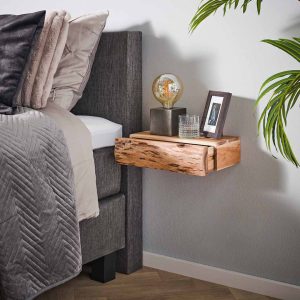Sleep in Style: Upgrade Your Bedroom with a Japanese Solid Wood Bed
Japanese solid wood beds have a rich history and cultural significance in Japan. Traditionally, the Japanese slept on futons placed on tatami mats, but over time, the use of solid wood beds became more popular. These beds are known for their simplicity, elegance, and functionality.
One of the key characteristics of Japanese solid wood beds is their minimalistic design. They are typically low to the ground and have clean lines, which create a sense of tranquility and harmony in the bedroom. The use of natural materials, such as solid wood, adds to their appeal.
Benefits of Sleeping on a Japanese Solid Wood Bed
Sleeping on a Japanese solid wood bed can have several benefits for your overall sleep quality and health. Firstly, these beds provide excellent support for your body, promoting better posture and spinal alignment. The low height of the bed also makes it easier to get in and out of bed, reducing strain on your joints.
Additionally, Japanese solid wood beds are made from natural materials, such as oak or walnut, which are eco-friendly and sustainable. These beds are also highly durable and can last for many years with proper care. This makes them a cost-effective investment in the long run.
Choosing the Right Japanese Solid Wood Bed for Your Bedroom
When choosing a Japanese solid wood bed for your bedroom, there are several factors to consider. Firstly, you need to determine the size and dimensions that will fit your space. Measure your room carefully to ensure that the bed will fit comfortably without overwhelming the space.
Next, consider the type of wood and finish that you prefer. Oak and walnut are popular choices for their durability and natural beauty. The finish can range from a light natural stain to a darker, more rustic look.
Design and style are also important considerations. Japanese solid wood beds come in various styles, from traditional to modern. Choose a style that complements the overall aesthetic of your bedroom.
Finally, consider your budget. Japanese solid wood beds can range in price depending on the quality of the materials and craftsmanship. Set a budget and stick to it, but also keep in mind that investing in a high-quality bed will ensure its longevity.
How to Style Your Bedroom with a Japanese Solid Wood Bed
Styling your bedroom with a Japanese solid wood bed can create a serene and minimalist atmosphere. Start by choosing a color scheme that complements the natural tones of the wood. Neutral colors, such as whites, grays, and earth tones, work well with the simplicity of the bed.
Incorporate minimalist decor and accessories to enhance the Zen-inspired aesthetic. Avoid clutter and choose only a few key pieces that have meaning to you. Consider adding elements of nature, such as plants or natural textiles, to bring a sense of tranquility to the space.
Lighting is also crucial in creating the right ambiance. Opt for soft, warm lighting that creates a cozy and relaxing atmosphere. Use dimmers or bedside lamps to control the intensity of the light.
Maintenance Tips for Your Japanese Solid Wood Bed
To keep your Japanese solid wood bed looking its best, regular maintenance is essential. Start by cleaning and dusting the bed regularly to remove any dirt or debris. Use a soft cloth or brush to gently wipe down the surface of the wood.
Polishing and oiling the wood periodically can help maintain its natural beauty and protect it from drying out. Use a high-quality wood polish or oil specifically designed for solid wood furniture. Follow the manufacturer’s instructions for application.
To prevent scratches and damage, use coasters or felt pads under any objects that may come into contact with the bed. Avoid placing hot or wet items directly on the surface of the wood.
The History and Culture of Japanese Solid Wood Beds

The use of solid wood beds in Japan has a long history that dates back centuries. Traditionally, the Japanese slept on futons placed on tatami mats, which were rolled up and stored during the day to create more space in the room. However, as Japan modernized, the use of solid wood beds became more common.
Japanese solid wood beds have had a significant influence on modern design and architecture. Their minimalistic and functional design principles have been adopted by designers around the world. The clean lines and simplicity of these beds have become synonymous with Japanese aesthetics.
In addition to their practicality, Japanese solid wood beds also have artistic and aesthetic value. The craftsmanship and attention to detail that goes into making these beds is highly regarded. Many Japanese artisans specialize in creating these beds using traditional woodworking techniques.
Comparing Japanese Solid Wood Beds to Other Bed Types
When comparing Japanese solid wood beds to other bed types, there are several factors to consider. Box springs and metal frames are commonly used in Western-style beds. While they may offer more height and storage options, they lack the simplicity and elegance of Japanese solid wood beds.
Platform beds and futons are closer in style to Japanese solid wood beds. Platform beds provide a similar low-profile design, but they often lack the natural materials and craftsmanship found in Japanese solid wood beds. Futons, on the other hand, are similar to traditional Japanese sleeping arrangements but lack the durability and longevity of solid wood beds.
Adjustable beds and air mattresses offer different levels of customization and comfort but may not provide the same aesthetic appeal as Japanese solid wood beds. Ultimately, the choice between different bed types depends on personal preference and the desired style for your bedroom.
The Environmental Benefits of Japanese Solid Wood Beds
Japanese solid wood beds offer several environmental benefits compared to other bed types. Firstly, the use of sustainable forestry practices ensures that the wood used in these beds is sourced responsibly. This helps protect forests and promotes biodiversity.
Additionally, Japanese solid wood beds are made from natural and non-toxic materials. This means that they do not release harmful chemicals into the air, promoting a healthier indoor environment. The use of natural materials also reduces the carbon footprint associated with the production and disposal of synthetic materials.
Frequently Asked Questions About Japanese Solid Wood Beds
1. Are they comfortable?
Yes, Japanese solid wood beds can be very comfortable. The low-profile design and solid wood construction provide excellent support for your body.
2. How do I assemble and disassemble them?
Most Japanese solid wood beds come with detailed instructions for assembly. They typically require basic tools, such as a screwdriver or Allen wrench. Disassembly is usually straightforward and can be done in reverse order.
3. Can I use a regular mattress on a Japanese solid wood bed?
Yes, you can use a regular mattress on a Japanese solid wood bed. However, keep in mind that the low height of the bed may affect the overall comfort and accessibility of the mattress.
Where to Find and Purchase Japanese Solid Wood Beds
Japanese solid wood beds can be found at various retailers and online marketplaces. Online retailers often offer a wide selection of styles and sizes to choose from. Local furniture stores and showrooms may also carry Japanese solid wood beds, allowing you to see and feel the quality before making a purchase.
For those looking for a more personalized touch, custom-made options and artisanal craftsmanship are available. These beds are often made to order and can be customized to fit your specific needs and preferences.
In conclusion, Japanese solid wood beds offer a unique blend of simplicity, elegance, and functionality. They provide numerous benefits for sleep quality, posture, and overall health. When choosing a Japanese solid wood bed, consider factors such as size, wood type, design, and budget. Styling your bedroom with a Japanese solid wood bed can create a serene and minimalist atmosphere. Regular maintenance is essential to keep your bed looking its best. Japanese solid wood beds have a rich history and cultural significance, and their influence can be seen in modern design and architecture. They offer several environmental benefits compared to other bed types. Frequently asked questions about Japanese solid wood beds include their comfort, assembly, and compatibility with regular mattresses. Japanese solid wood beds can be found at various retailers and online marketplaces, and custom-made options are also available for those seeking a more personalized touch.






